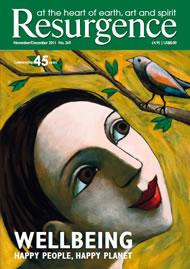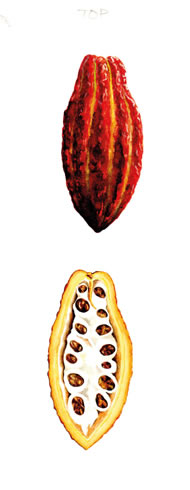We all know that there’s an association between food and happiness. When we want to celebrate, we feast. When we need to welcome somebody home, or show somebody that we care, we do it with food. What’s better than crouching by an open fire in winter with a carefully loaded toasting fork, or sitting under a tree with a picnic in summer?
I get joy from every aspect of food – growing it and harvesting it, selecting it and purchasing it, teaching people to cook it well and seeing how their new skills make them happy. But I get a particular joy out of sharing food. I suppose it’s like giving a present of any kind, especially a present that has a lot of me in it. On a more fundamental level, giving somebody food is an act of generosity, no matter what the circumstances. In some circumstances, food is love. In other circumstances, food is life.
I get joy out of making food. I enjoy taking ingredients that need my work, and giving my time and physical effort to convert them into something more edible. Labour-saving kitchen gadgets mystify me because I like chopping things up, and peeling things. I like blanching almonds, and popping hot tomatoes out of their puckered skins. It’s especially gratifying to be able to take uninspiring scraps and convert them into something special.
Of course, there is also enormous satisfaction to be had from sourcing the very best ingredients and creating an absolute masterpiece, something stunning, something with the ‘wow’ factor. But that leads me to ask why I consider any food to be ‘special’, or a ‘masterpiece’. What makes me say “Wow!” when I look at a plate of food? It can’t be just the anticipation of the physical gratification that I will probably feel when my stomach is nicely full. Perhaps I’m appreciating the work that I know has gone into a dish, or seeing food as a kind of art or craft. Perhaps I’m celebrating the dexterity or the audacity of the chef.
Leaving aside the obvious fact that we must eat to live, and that we are biologically programmed to seek out food for that reason alone, there must be other cultural or sociological reasons why we react with delight to certain kinds of food. If you were to offer me a freshly dug beetroot from your garden, I would be very happy to receive it. But if you were to hand me a box of expensive chocolates, there would be a different quality to my delight. By rights, being offered a home-grown and nurtured organic beetroot should mean much more to me than being offered a nibble of something expensive that came in a fancy box. But…
I’m beginning to think that the missing factor might be taste. We get joy from all our senses – from seeing, touching, smelling, hearing – so it stands to reason that joy can also be derived from tasting. So there’s the difference between the beetroot and the chocolate – the chocolate offers instant gratification. The beetroot requires a little work. Offer me a garlicky, oily, leafy salad dotted with chunks of cold beetroot and soft goat’s cheese, or a fabulously unctuous risotto topped with sweet roasted roots, and the beetroot will assert its allure.
As I write, I am savouring those dishes, and I’m not sure how it’s happening. I’m not expecting their imminent arrival, unless I leap from my chair and get my apron on. It’s a bit like reading cookbooks for pleasure – which I do all the time. Other people might enjoy magazines illustrated with photographs of beautiful country homes or stunning silver beaches. Such reading matter is widely supposed to transport the reader away from banal reality. I love reading recipes – not because I necessarily plan to make them, any more than the person who enjoys reading travelogues necessarily has the impulse to book a ticket and try the adventure first-hand. I think I’m actually getting enjoyment through stimulating a part of my brain that is linked to my taste buds, simply by imagining the tastes.
Here’s a fun test. Can you imagine the taste of chocolate in your mouth? Now add a splash of orange oil. Can you tell the difference? Go back to the original chocolate, and try adding lime, or coffee. Does it work for you? It does for me. Does it depend on having actually experienced those tastes, as if they were memories? Can you devise a combination of ingredients that you’ve never experienced in the same mouthful, and get some sense of what the taste might be? Beetroot and chocolate? Perhaps the ability to imagine those flavours and, more than that, to really sense them, is part of the toolkit of the creative cook.
I set out to create a dish that would make me happy. The first ingredient that sprang to mind was, inevitably, chocolate. There has been a fair bit of research into this – apparently the reasons why people love chocolate are all bound up with fat, and the melting ‘mouth feel’ that you get from cocoa butter, which softens at body heat. Chocolate contains various chemicals, including anandamide and phenylethylamine, which theoretically means chocolate might have the potential to affect the brain, making you feel relaxed and satisfied. It has also been suggested that tryptophan in chocolate can stimulate the body’s production of serotonin, which might have a calming effect. Nothing has been proved yet, although it seems to be a popular area of research.
So, chocolate. What else? I let my mind dawdle through the sweet delights I have sampled recently, waiting for something to trigger a ‘happy’ reaction in my brain, and the next thing that came to mind was crème brûlée. I find it very hard to resist. I’ve had unsatisfactory examples – ice-cold lumps of cream underneath hot sticky sugar – so, for me, the temperature has to be uniform and the topping not sticky, but crisp and hard enough to crack with the back of a spoon. The sugar must be burned (otherwise it’s not a brûlée) but not so blackened that it tastes of nothing but soot. Most importantly, the ‘crème’ part needs to be smooth, smooth, smooth. I once tried a version that contained blueberries. It didn’t work. I tried a version made with stem ginger. Delicious, but the texture was ruined by ‘bits’. I don’t want to chew a crème brûlée.
Might there be scope for a marriage between chocolate and crème brûlée? I mulled it over for a while, and then started some experiments. I made myself very happy, by cooking with lovely ingredients, making something delicious for my willing tasters, and, not least, having great scary fun with my little cook’s blowtorch (and there’s my big recommendation for the Christmas stocking of the cook you love). I hope the recipe that follows will make you as happy as it made me!
Chocolate ginger crackpots
I’ve called these crackpots because you should need to crack the sugar on top to get into the chocolate…
For the base:
100g chocolate ginger biscuits
200g butter
For the chocolate mixture:
300ml single cream
200g good-quality dark chocolate
3 free-range egg yolks
2 tbsp brandy
2 tbsp ginger syrup (comes in a jar with stem ginger)
20g butter
For the topping:
10g hazelnuts
4 tsp caster sugar
Makes 4
You will need four ramekins, espresso cups or robust teacups
* First make the base. Put the biscuits into a heavy-duty plastic bag, hold it firmly closed and bash the biscuits into fine crumbs with a rolling pin. (You could probably use a food processor to do this – but why would you?) Melt the butter in a saucepan, turn off the heat and stir in the crumbs. Divide the mixture between the ramekins or cups and press down firmly. Chill the pots for an hour or so.
* Warm the cream in a pan over a low heat. It only needs to be warm enough to melt the chocolate, which you now need to break up and add to the pan. Stir the mixture to keep it smooth, then stir in the egg yolks, brandy and ginger syrup. Finally, melt in the butter and stir well to combine everything.
* Divide the warm mixture between the ramekins or cups and let them cool a little before returning them to the fridge. Allow the pots to chill for at least four hours – overnight if possible.
* To make the topping, first roast the hazelnuts in a dry pan until their skins become dry and crisp. Keep them moving in the pan so that they don’t burn. While they’re still hot, wrap them in a clean, dampened tea towel and rub them together to take off the skins (it’s OK to leave some on). Now chop them finely.
* Cover the top of each pot with a layer of chopped nuts, then sprinkle a teaspoon of caster sugar evenly over each one. Using a cook’s mini-blowtorch, melt and brown the sugar. Then return the pots to the fridge for 10 minutes so that they are chilled and the topping is crisp and hard.
* Remove from the fridge and serve right away, before the sugar dissolves and gets sticky.
For more information, visit: www.veggiefoodwriter.co.uk








